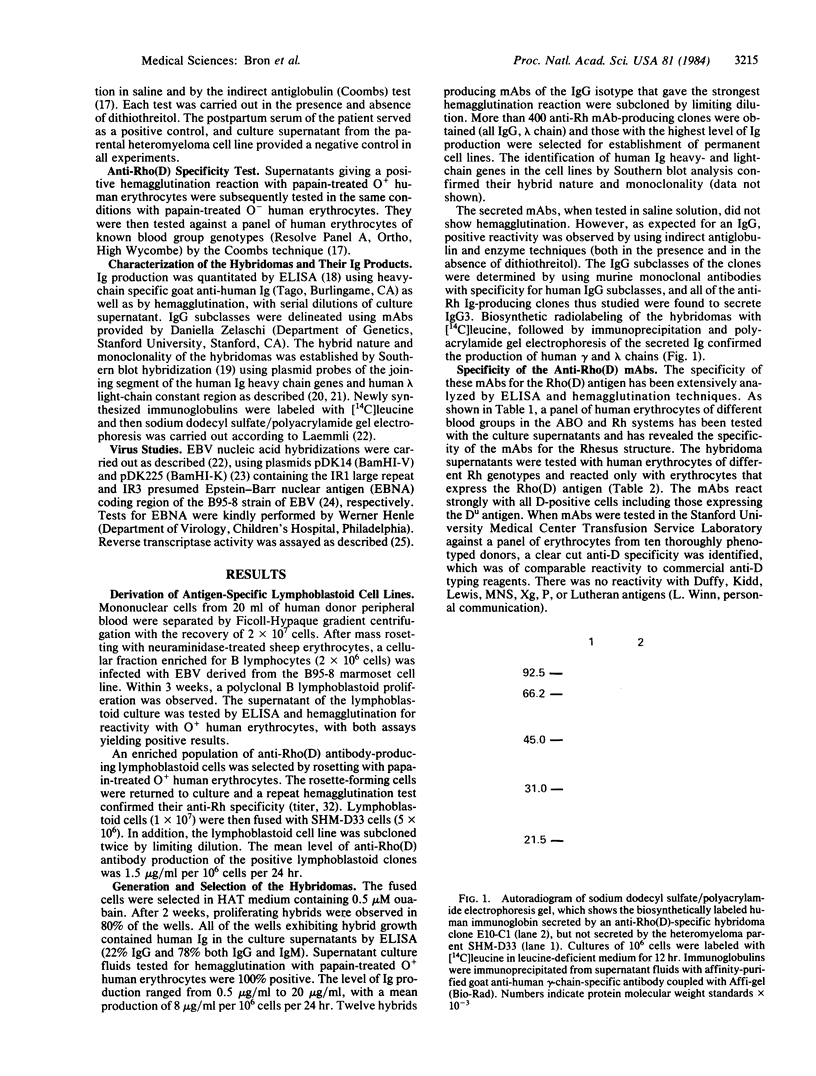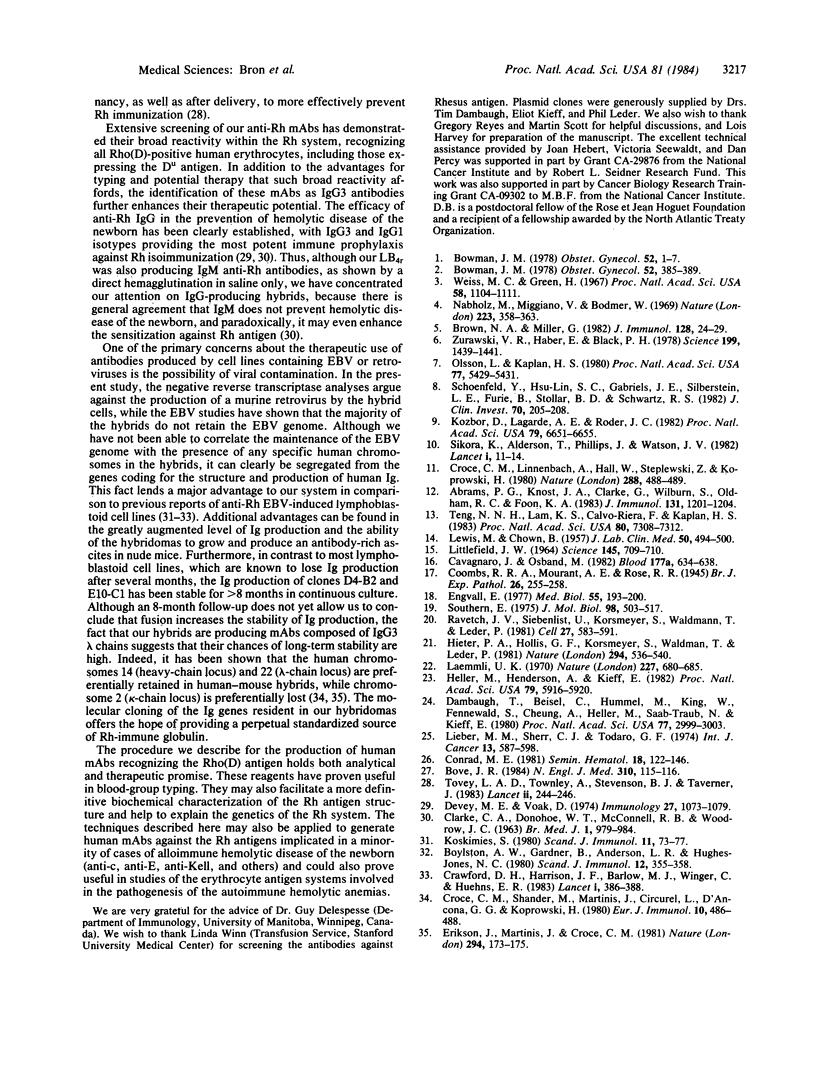Abstract
An Epstein-Barr virus (EBV)-transformed human B-cell line ( LB4r ) producing anti-Rhesus [Rho(D) antigen] antibody was fused with a non-immunoglobulin-producing mouse-human heteromyeloma ( SHM - D33 ) and selected in hypoxanthine/aminopterin/thymidine medium containing 0.5 microM ouabain. Surviving hybrids found to secrete specific anti-Rho(D) antibody were cloned by limiting dilution. Two clones (D4-B2 and E10-C1) producing high levels (12 and 20 micrograms/ml per 10(6) cells per 24 hr, respectively) of monospecific antibody (IgG3, lambda chain) were selected for expansion and further characterization. Compared to the parental cell line ( LB4r ), these hybridoma cell lines presented several advantages: antibody production was increased 10-fold, cloning efficiency was improved, and the EBV genome was not retained. Antibody production has been stable for greater than 8 months. These human monoclonal anti-Rho(D) antibodies have demonstrated utility in routine blood-group typing. They may also prove useful in the biochemical and genetic characterization of the Rh antigen system. Most important, they offer a source of Rh-immune globulin for the prevention of Rh immunization and alloimmune hemolytic disease of the newborn.
Full text
PDF



Images in this article
Selected References
These references are in PubMed. This may not be the complete list of references from this article.
- Abrams P. G., Knost J. A., Clarke G., Wilburn S., Oldham R. K., Foon K. A. Determination of the optimal human cell lines for development of human hybridomas. J Immunol. 1983 Sep;131(3):1201–1204. [PubMed] [Google Scholar]
- Bove J. R. Transfusion-associated AIDS--a cause for concern. N Engl J Med. 1984 Jan 12;310(2):115–116. doi: 10.1056/NEJM198401123100209. [DOI] [PubMed] [Google Scholar]
- Bowman J. M. Suppression of Rh isoimmunization. A review. Obstet Gynecol. 1978 Oct;52(4):385–393. [PubMed] [Google Scholar]
- Bowman J. M. The management of Rh-Isoimmunization. Obstet Gynecol. 1978 Jul;52(1):1–16. [PubMed] [Google Scholar]
- Boylston A. W., Gardner B., Anderson R. L., Hughes-Jones N. C. Production of human IgM anti-D in tissue culture by EB-virus-transformed lymphocytes. Scand J Immunol. 1980;12(4):355–358. doi: 10.1111/j.1365-3083.1980.tb00077.x. [DOI] [PubMed] [Google Scholar]
- Brown N. A., Miller G. Immunoglobulin expression by human B lymphocytes clonally transformed by Epstein Barr virus. J Immunol. 1982 Jan;128(1):24–29. [PubMed] [Google Scholar]
- CLARKE C. A., DONOHOE W. T., McCONNELL R. B., WOODROW J. C., FINN R., KREVANS J. R., KULKE W., LEHANE D., SHEPPARD P. M. Further experimental studies on the prevention of Rh haemolytic disease. Br Med J. 1963 Apr 13;1(5336):979–984. doi: 10.1136/bmj.1.5336.979. [DOI] [PMC free article] [PubMed] [Google Scholar]
- Conrad M. E. Diseases transmissible by blood transfusion: viral hepatitis and other infectious disorders. Semin Hematol. 1981 Apr;18(2):122–146. [PubMed] [Google Scholar]
- Crawford D. H., Barlow M. J., Harrison J. F., Winger L., Huehns E. R. Production of human monoclonal antibody to rhesus D antigen. Lancet. 1983 Feb 19;1(8321):386–388. doi: 10.1016/s0140-6736(83)91502-7. [DOI] [PubMed] [Google Scholar]
- Croce C. M., Linnenbach A., Hall W., Steplewski Z., Koprowski H. Production of human hybridomas secreting antibodies to measles virus. Nature. 1980 Dec 4;288(5790):488–489. doi: 10.1038/288488a0. [DOI] [PubMed] [Google Scholar]
- Dambaugh T., Beisel C., Hummel M., King W., Fennewald S., Cheung A., Heller M., Raab-Traub N., Kieff E. Epstein-Barr virus (B95-8) DNA VII: molecular cloning and detailed mapping. Proc Natl Acad Sci U S A. 1980 May;77(5):2999–3003. doi: 10.1073/pnas.77.5.2999. [DOI] [PMC free article] [PubMed] [Google Scholar]
- Devey M. E., Voak D. A critical study of the IgG subclasses of Rh anti-D antibodies formed in pregnancy and in immunized volunteers. Immunology. 1974 Dec;27(6):1073–1079. [PMC free article] [PubMed] [Google Scholar]
- Engvall E. Quantitative enzyme immunoassay (ELISA) in microbiology. Med Biol. 1977 Aug;55(4):193–200. [PubMed] [Google Scholar]
- Erikson J., Martinis J., Croce C. M. Assignment of the genes for human lambda immunoglobulin chains to chromosome 22. Nature. 1981 Nov 12;294(5837):173–175. doi: 10.1038/294173a0. [DOI] [PubMed] [Google Scholar]
- Heller M., Henderson A., Kieff E. Repeat array in Epstein-Barr virus DNA is related to cell DNA sequences interspersed on human chromosomes. Proc Natl Acad Sci U S A. 1982 Oct;79(19):5916–5920. doi: 10.1073/pnas.79.19.5916. [DOI] [PMC free article] [PubMed] [Google Scholar]
- Hieter P. A., Hollis G. F., Korsmeyer S. J., Waldmann T. A., Leder P. Clustered arrangement of immunoglobulin lambda constant region genes in man. Nature. 1981 Dec 10;294(5841):536–540. doi: 10.1038/294536a0. [DOI] [PubMed] [Google Scholar]
- Koskimies S. Human lymphoblastoid cell line producing specific antibody against Rh-antigen D. Scand J Immunol. 1980;11(1):73–77. doi: 10.1111/j.1365-3083.1980.tb00210.x. [DOI] [PubMed] [Google Scholar]
- Kozbor D., Lagarde A. E., Roder J. C. Human hybridomas constructed with antigen-specific Epstein-Barr virus-transformed cell lines. Proc Natl Acad Sci U S A. 1982 Nov;79(21):6651–6655. doi: 10.1073/pnas.79.21.6651. [DOI] [PMC free article] [PubMed] [Google Scholar]
- LEWIS M., CHOWN B. A short albumin method for the demonstration of isohemagglutinins, particularly incomplete Rh antibodies. J Lab Clin Med. 1957 Sep;50(3):494–497. [PubMed] [Google Scholar]
- LITTLEFIELD J. W. SELECTION OF HYBRIDS FROM MATINGS OF FIBROBLASTS IN VITRO AND THEIR PRESUMED RECOMBINANTS. Science. 1964 Aug 14;145(3633):709–710. doi: 10.1126/science.145.3633.709. [DOI] [PubMed] [Google Scholar]
- Laemmli U. K. Cleavage of structural proteins during the assembly of the head of bacteriophage T4. Nature. 1970 Aug 15;227(5259):680–685. doi: 10.1038/227680a0. [DOI] [PubMed] [Google Scholar]
- Lieber M. M., Sherr C. J., Todaro G. J. S-tropic murine type-C viruses: frequency of isolation from continuous cell lines, leukemia virus preparations and normal spleens. Int J Cancer. 1974 May 15;13(5):587–598. doi: 10.1002/ijc.2910130503. [DOI] [PubMed] [Google Scholar]
- Nabholz M., Miggiano V., Bodmer W. Genetic analysis with human--mouse somatic cell hybrids. Nature. 1969 Jul 26;223(5204):358–363. doi: 10.1038/223358a0. [DOI] [PubMed] [Google Scholar]
- Olsson L., Kaplan H. S. Human-human hybridomas producing monoclonal antibodies of predefined antigenic specificity. Proc Natl Acad Sci U S A. 1980 Sep;77(9):5429–5431. doi: 10.1073/pnas.77.9.5429. [DOI] [PMC free article] [PubMed] [Google Scholar]
- Ravetch J. V., Siebenlist U., Korsmeyer S., Waldmann T., Leder P. Structure of the human immunoglobulin mu locus: characterization of embryonic and rearranged J and D genes. Cell. 1981 Dec;27(3 Pt 2):583–591. doi: 10.1016/0092-8674(81)90400-1. [DOI] [PubMed] [Google Scholar]
- Shoenfeld Y., Hsu-Lin S. C., Gabriels J. E., Silberstein L. E., Furie B. C., Furie B., Stollar B. D., Schwartz R. S. Production of autoantibodies by human-human hybridomas. J Clin Invest. 1982 Jul;70(1):205–208. doi: 10.1172/JCI110595. [DOI] [PMC free article] [PubMed] [Google Scholar]
- Sikora K., Alderson T., Phillips J., Watson J. V. Human hybridomas from malignant gliomas. Lancet. 1982 Jan 2;1(8262):11–14. doi: 10.1016/s0140-6736(82)92556-9. [DOI] [PubMed] [Google Scholar]
- Southern E. M. Detection of specific sequences among DNA fragments separated by gel electrophoresis. J Mol Biol. 1975 Nov 5;98(3):503–517. doi: 10.1016/s0022-2836(75)80083-0. [DOI] [PubMed] [Google Scholar]
- Teng N. N., Lam K. S., Calvo Riera F., Kaplan H. S. Construction and testing of mouse--human heteromyelomas for human monoclonal antibody production. Proc Natl Acad Sci U S A. 1983 Dec;80(23):7308–7312. doi: 10.1073/pnas.80.23.7308. [DOI] [PMC free article] [PubMed] [Google Scholar]
- Tovey L. A., Townley A., Stevenson B. J., Taverner J. The Yorkshire antenatal anti-D immunoglobulin trial in primigravidae. Lancet. 1983 Jul 30;2(8344):244–246. doi: 10.1016/s0140-6736(83)90232-5. [DOI] [PubMed] [Google Scholar]
- Weiss M. C., Green H. Human-mouse hybrid cell lines containing partial complements of human chromosomes and functioning human genes. Proc Natl Acad Sci U S A. 1967 Sep;58(3):1104–1111. doi: 10.1073/pnas.58.3.1104. [DOI] [PMC free article] [PubMed] [Google Scholar]
- Zurawski V. R., Jr, Haber E., Black P. H. Production of antibody to tetanus toxoid by continuous human lymphoblastoid cell lines. Science. 1978 Mar 31;199(4336):1439–1441. doi: 10.1126/science.204013. [DOI] [PubMed] [Google Scholar]




